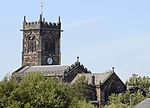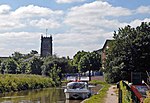Ravenscroft Hall

Ravenscroft Hall is a country house standing to the east of the B5309 road (King Street) about 1 mile (1.6 km) to the north of Middlewich, Cheshire, England. The house was built in 1837 for William T. Buchanan, replacing a former Jacobean house. It was extended, possibly in 1852 when the house was bought by the Moss family, and again in 1877. The house has since been divided into two dwellings. It is constructed in roughcast and yellow brick, with stone dressings and slate roofs. The house is in two storeys, with a main front of five bays, and a five-bay extension to the northeast. The garden front also has five bays. The house has an Ionic porch, and an Italianate belvedere. It is recorded in the National Heritage List for England as a designated Grade II listed building.
Excerpt from the Wikipedia article Ravenscroft Hall (License: CC BY-SA 3.0, Authors, Images).Ravenscroft Hall
King Street,
Geographical coordinates (GPS) Address Nearby Places Show on map
Geographical coordinates (GPS)
| Latitude | Longitude |
|---|---|
| N 53.20479 ° | E -2.44564 ° |
Address
King Street
King Street
CW10 9LD
England, United Kingdom
Open on Google Maps









